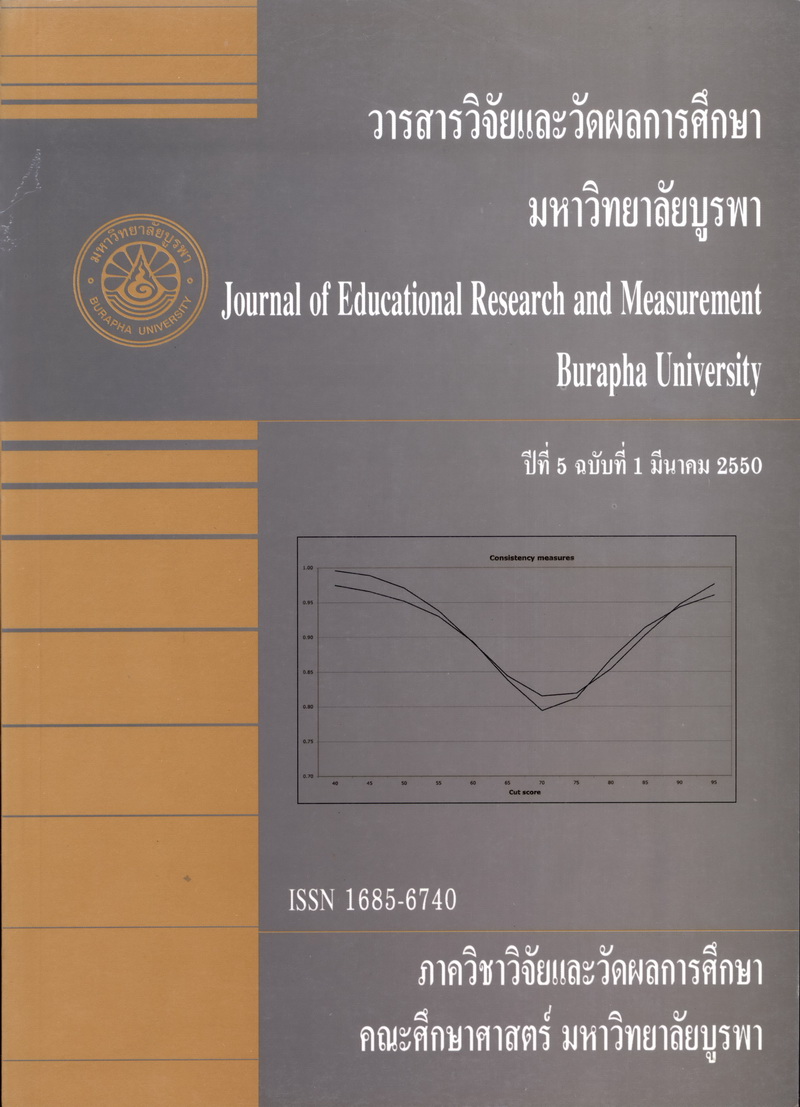การตรวจสอบการทำหน้าที่ต่างกันของข้อสอบในแบบทดสอบพหุมิติ: การเปรียบเทียบประสิทธิภาพระหว่างวิธีการวิเคราะห์องค์ประกอบจำกัด กับวิธีถดถอยโลจิสติก
Main Article Content
Abstract
การวิจัยนี้มีวัตถุประสงค์เพื่อเปรียบเทียบประสิทธิภาพของวิธีการตรวจสอบการทำหน้าที่ต่างกันของข้อสอบในแบบทดสอบพหุมิติระหว่างวิธีการวิเคราะห์องค์ประกอบจำกัดกับวิธีถดถอยโลจิสติก ภายใต้เงื่อนไข 18 เงื่อนไข (3× 3× 2) คือ ขนาดของกลุ่มตัวอย่าง 3 ขนาด (2,000 คน 1,000 คน และ 300 คน) ความยาวของแบบทดสอบ 3 ขนาด (40 ข้อ 30 ข้อ และ 20 ข้อ) และ เกณฑ์การจับคู่ 2 เกณฑ์ (คะแนนรวมทั้งฉบับ = TS และ คะแนนแบบทดสอบย่อย = SS) เมื่อใช้ผลการตรวจสอบการทำหน้าที่ ต่างกันของข้อสอบโดยวิธีซิปเทสท์เป็นเกณฑ์สำหรับการเปรียบเทียบประสิทธิภาพ กลุ่มตัวอย่างเป็นนักเรียนชั้นประถมศึกษาปีที่ 6 สังกัดสำนักงานคณะกรรมการการศึกษาขั้นพื้นฐาน ปีการศึกษา 2546 ที่เข้าสอบวัดผลสัมฤทธิ์ทางการเรียนระดับชาติวิชาภาษาไทย จำนวน 2,000 คน วิเคราะห์ค่าสถิติพื้นฐานโดยใช้โปรแกรม SPSS ตรวจสอบความตรงเชิงโครงสร้างด้วยการวิเคราะห์องค์ประกอบ
เชิงยืนยันอันดับสองโดยใช้โปรแกรม LISREL 8.50 และ ตรวจสอบการทำหน้าที่ต่างกันของข้อสอบโดยใช้โปรแกรม SIBTEST LISREL 8.50 และ SPSS ผลการวิจัยปรากฏว่า
1. วิธีถดถอยโลจิสติก (LR) มีประสิทธิภาพไม่แตกต่างกันกับวิธีวิเคราะห์องค์ประกอบจำกัด (RFA) ในการตรวจสอบการทำหน้าที่ต่างกันของข้อสอบในแบบทดสอบพหุมิติ 2 เงื่อนไข (ขนาดของกลุ่มตัวอย่าง × ความยาวของแบบทดสอบ × เกณฑ์
การจับคู่) คือ 1,000 คน× 20 ข้อ× SS และ 300 คน× 20 ข้อ× SS
2. วิธี LR มีประสิทธิภาพมากกว่าวิธี RFA ในการตรวจสอบการทำหน้าที่ต่างกันของข้อสอบในแบบทดสอบพหุมิติ 16 เงื่อนไข คือ 1) 2,000 คน× 40 ข้อ× TS 2) 2,000 คน× 40 ข้อ× SS 3) 2,000 คน× 30 ข้อ× TS 4) 2,000 คน× 30 ข้อ× SS 5) 2,000 คน× 20 ข้อ× TS 6) 2,000 คน× 20 ข้อ× SS 7) 1,000 คน× 40 ข้อ× TS 8) 1,000 คน× 40 ข้อ× SS 9) 1,000 คน× 30 ข้อ × TS 10) 1,000 คน× 30 ข้อ× SS 11) 1,000 คน× 20 ข้อ× TS 12) 300 คน× 40 ข้อ× TS 13) 300 คน× 40 ข้อ× SS 14) 300 คน× 30 ข้อ × TS 15) 300 คน× 30 ข้อ× SS และ 16) 300 คน× 20 ข้อ× TS เนื่องจาก วิธี LR มีอัตราความคลาดเคลื่อนประเภทที่ 1 น้อยกว่าวิธี RFA อย่างมีนัยสำคัญทางสถิติที่ระดับ .05
Detecting Differential Item Functioning in Multidimensional Tests: A Comparison of the Relative Efficiency of Restricted Factor Analysis and Logistic Regression Methods
The purpose of this research was to compare the relative efficiency of Restricted Factor Analysis and Logistic Regression methods for detecting differential item functioning (DIF) in multidimensional tests under the 18 conditions (3x 3x 2), 3 sizes of samples (2,000 samples, 1,000 samples, 300 samples), 3 sizes of test length (40 items, 30 items, 20 items) and 2 matching criterions (total test score = TS, subtest score = SS), by using SIBTEST method for the criteria. The sample consisted of 2,000 Grade-six students under the Basic Education Commission Office, in academic year 2003 who entered the national achievement test on the Thai Language. Descriptive statistics were dervied by using SPSS, while a
second-order confirmatory factor analysis for construct validity was conducted by applying LISREL 8.50. Detecting DIF by using the SIBTEST, LISREL 8.50, and SPSS.
The results were as follow:
1. The Logistic Regression (LR) method was found having the same efficiency as Restricted Factor Analysis (RFA) method in detecting DIF for multidimensional test. In these two conditions, it was 1,000 samples x 20 items x SS and 300 samples x 20 items x SS.
2. The LR method was found more efficient than RFA method for detecting DIF for multidimensional test in the 16 conditions: 1) 2,000x 40x TS 2) 2,000x 40x SS 3) 2,000x 30x TS 4) 2,000x 30x SS 5) 2,000x 20x TS 6) 2,000x 20x SS 7) 1,000x 40x TS 8) 1,000x 40x SS 9) 1,000x 30x TS 10) 1,000x 30x SS 11) 1,000x 20x TS 12) 300x 40x
TS 13) 300x40x SS 14) 300x 30x TS 15) 300x 30x SS and 16) 300x 20x TS. This was because of LR method had less the Type I Error Rate than RFA method.
